Knowing the employee engagement metrics of your organization can help to improve performance and productivity. Find out why and how right here.

.png)
Start tracking smarter. Download your free Internal Comms Metric Guide now!
Access NowThe vitality and success of an organization often hinge upon the engagement and satisfaction of its employees. 2024 Gallup research shows that employee stress levels have remained at a record high, with 44% of employees globally admitting they are stressed. The company’s research also shows that engaged employees are less likely to report feeling stress than those who are less engaged.
With this in mind, Gallup has produced a 2024 Employee Strategies Checklist to help organizations create employee enthusiasm and “heal the stress.” One of the top five ways to increase employee engagement and “make 2024 your organization’s year of mission, purpose, and quality” is by measuring engagement.
Quantifying engagement sends a message to employees that you value their feedback and are interested in their well-being. Whether you have an established and reliable method or need to create a means of assessing your employees' enthusiasm, measuring engagement is crucial for establishing a foundational understanding of your workforce and its requirements. The objective is to initiate a dialogue between managers and each employee.
“Measuring engagement is essential to having a baseline understanding of your workforce and its needs.”
Gallup
Now that we’ve established why we measure employee engagement, we’re going to examine 15 vital employee engagement metrics. We will also illustrate how to astutely apply them to optimize engagement strategies and increase the number of engaged employees in your organization. We intend to provide leaders, HR professionals, and individuals vested in an organization's success, with a comprehensive understanding of these employee engagement metrics. The insights we will provide can potentially shape an organization's culture, performance, and productivity.
Employee engagement metrics are crucial data points that we use to measure the level of active participation, commitment, and enthusiasm of staff members toward their job and organizational objectives. These metrics enable firms to assess and enhance their internal atmosphere, noting where improvements are needed to drive greater engagement.
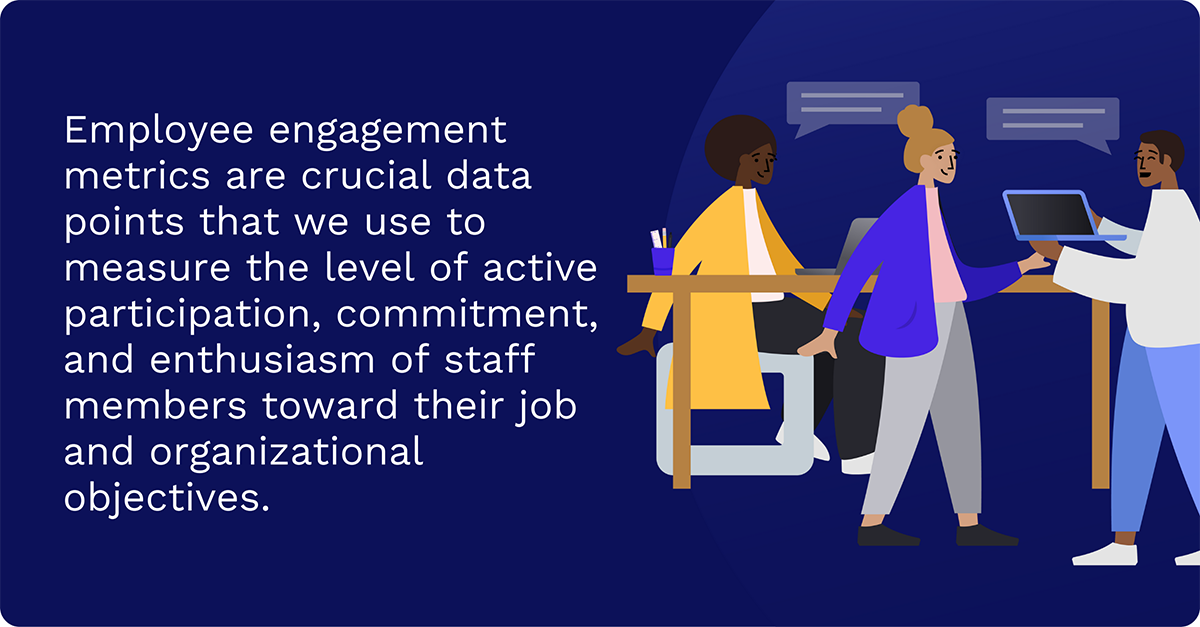
Employee engagement is not about how happy or satisfied an employee is but rather about their emotional commitment and resilience towards their work and the business. Engaged employees are psychologically invested in the organization and dedicated to contributing to its success.
According to Gallagher’s State of the Sector 2023/24 report, 32% of respondents rated disengaged employees as a major challenge in their organizations. In addition, 19% stated they lack analytics or measurement, which tends to be an ongoing concern for larger organizations. At the same time, larger organizations utilize internal communication measurement tools more frequently than small or medium-sized organizations.
Metrics for employee engagement include a comprehensive range of measurements, from job satisfaction and personal growth metrics to diversity inclusion and company culture satisfaction metrics. These metrics can provide a holistic view of employee engagement within the organization.
A deeper understanding of these metrics can significantly benefit organizations as they shape their human resource strategies and employee engagement programs. Moreover, these measurements can offer actionable insights that can be harnessed to foster a resilient organization.
Elements can vary immensely when measuring the success of internal communications. For example, the Gallagher survey found that organizations generally measure reach — getting the message across via email, events, intranet, and online analytics as well as employee understanding of messages. They place less emphasis on business outcomes, understanding, behavior change, or overall satisfaction with internal communications.
Overall, 84% of respondents said they wanted to measure the impact of internal communications more often or comprehensively. When asked how often satisfaction with employees’ comms was measured, 60% responded, which was an increase of 5% from the previous survey. Slightly more (63%) focused on measuring behavior (a 10% increase), and 69% on understanding (a 6% increase). Data collection relating to reach had increased 14% to 77%, with 20% of respondents stating that their reach measurement is “always on.”
A point to note is that these metrics aren’t static. They change with time, reflecting the changing dynamics of the workplace and employee expectations. Therefore, they need to be tracked and analyzed continuously to keep pace with these changes. Ongoing analysis can also drive interventions that can enhance engagement levels and the overall well-being of staff.
Despite the crucial role these metrics play, businesses often face the challenge of choosing the most relevant metrics that will provide a clear, holistic picture of their employees’ engagement. Therefore, it’s critical to understand each metric, its importance, functionality, and how it aligns with your organizational goals to derive the most value from tracking employee engagement.
Aim to measure and enhance employee engagement. Adopt strategies that can improve employees’ connection with their tasks, team members, and company, thereby ensuring their psychological well-being. Ultimately, the goal is to foster a workforce that is actively invested in the organization’s success, demonstrating higher productivity, innovation, and loyalty.
Tracking metrics for employee engagement is critical to any organization’s success. By analyzing key metrics, businesses can pinpoint areas of strength and opportunities for improvement, leading to focused actions that drive overall performance. Furthermore, by exploring various key metrics, businesses can identify areas of strength and weakness, leading to focused improvements to maximize organizational success.
Data from Gallup underscores the importance of this practice, showing why it is so important to track metrics for employee engagement. According to its second-quarter 2024 report, only 32% of U.S. employees are fully engaged at work, while 16% are actively disengaged. This disengagement can lead to decreased productivity and increased turnover.
The company notes that while the US had not returned to pre-pandemic levels, improvements were pronounced in “foundational elements.” These include:
Culture Amp's 2024 analysis, The Great Regression: Employee Engagement in 2024, indicates that global employee engagement has returned to pre-pandemic levels, now at 71%.
These statistics highlight the critical need for organizations to regularly assess and address employee engagement to maintain a motivated and effective workforce.
According to Deloitte Insights’ lengthy 2024 Global Human Capital Trends report, organizations with robust employee engagement strategies experience an increase in productivity and a boost in profitability. Moreover, companies that actively monitor engagement metrics are considerably more likely to reduce turnover, underscoring the direct relationship between engaged employees and superior business outcomes.
“In an era of human-centered work, new sources of data and artificial intelligence can help organizations shift from measuring employee productivity to measuring human performance.”
Deloitte Insights
Employee satisfaction presents a comprehensive understanding of the staff members' perception of their work and company culture. When employees feel heard and appreciated, it boosts their morale, which results in increased productivity and a healthier work environment.
The trick is to quantify the data and identify the level of employee satisfaction. Whiteman points out that while dollars and manufacturing outputs are easy to quantify, people aren’t. This is because “they have uncontrollable variables that you can never, ever account for.”
High turnover is not just a loss of skill set and knowledge but also an added expense due to recruitment and training costs. Through employee feedback on engagement levels, organizations can identify the root causes of high attrition rates and strategically plan corrective measures.
Here, the issue is that many organizations made (and may still make) feedback, listening, and two-way communication optional. “It left a hole where many people were not getting any feedback,” says Whiteman.
Quantify the financial benefits of your internal communications
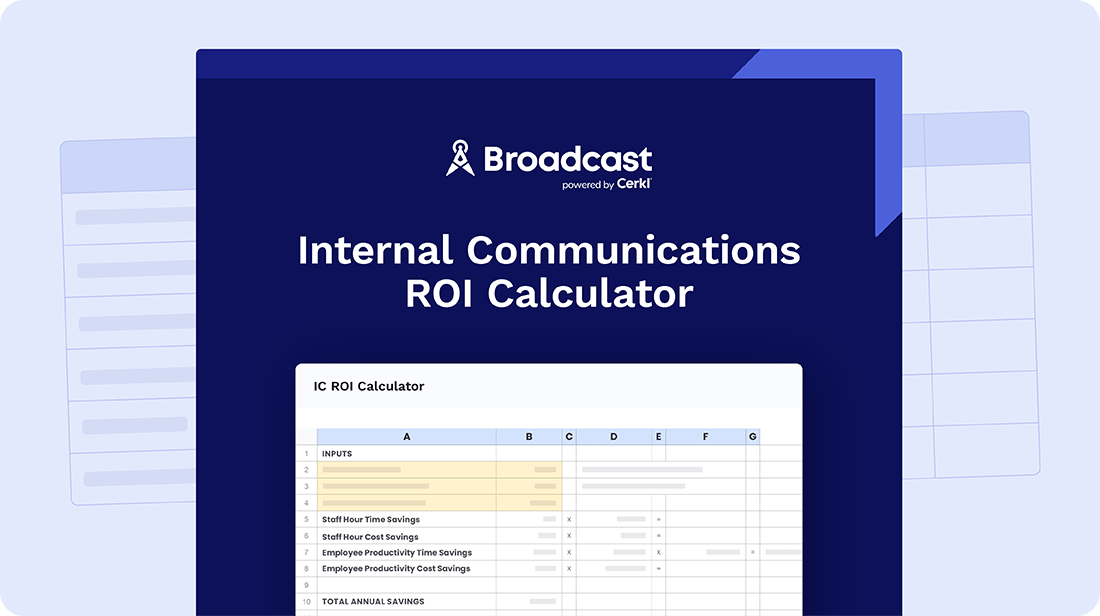
By tracking metrics such as the employee net promoter score (eNPS) and performance metrics, businesses can drive focus toward customer satisfaction and operational efficiency. A satisfied customer base and high operational productivity levels correlate strongly with financial success, resilience, and business growth.
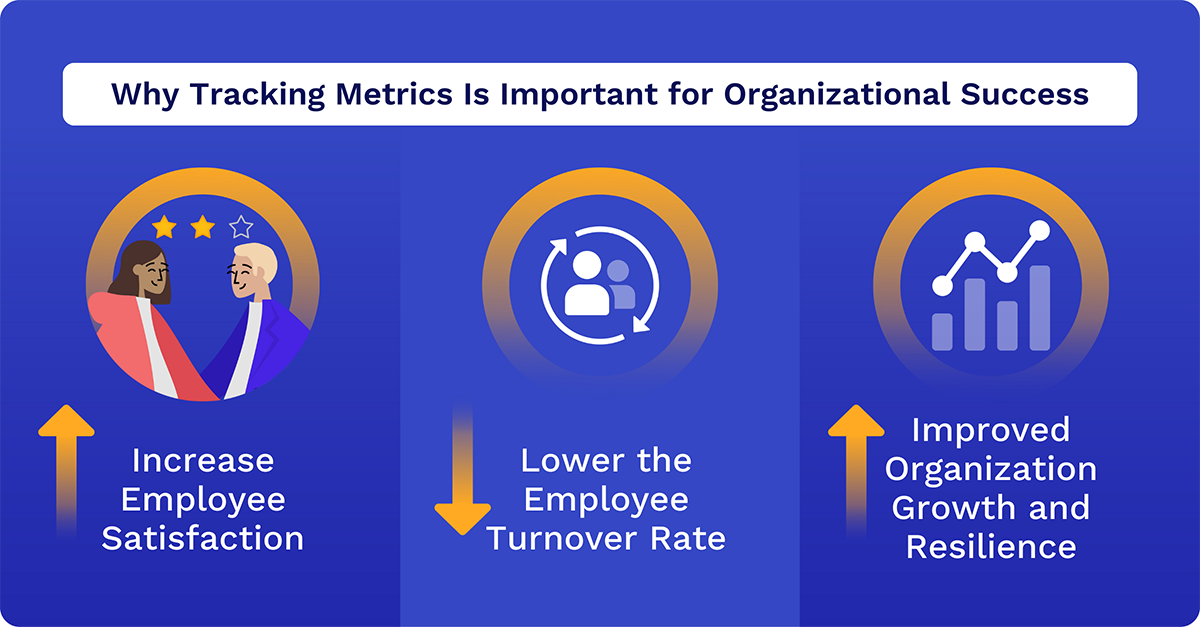
Understanding and improving employee engagement metrics is paramount to organizational success. Some common metrics that we use to measure employee engagement include employee satisfaction surveys, employee net promoter scores (NPS), turnover rates, absenteeism rates, and engagement scores based on employee responses to specific questions.
Let’s look at 15 important metrics to see why they matter.
The overall employee engagement score is a collective measure of how engaged, enthusiastic, and committed your staff members are. It's a single value that gives a broad snapshot of how individuals feel about their jobs. This score is often calculated through employee engagement surveys that focus on a variety of factors, such as employee satisfaction, productivity, and commitment. The greater the score, the more engaged the workforce is thought to be.
The employee net promoter score eNPS is a measure of how likely an employee is to recommend their organization as a great place to work. This is a clear indicator of employee engagement, satisfaction, and loyalty. This metric directly reflects the company's reputation among its employees and can be a very telling sign in terms of the health of the organization's culture.
Job satisfaction metrics gauge how fulfilled and satisfied employees are with their job roles, environment, responsibilities, and rewards. Research by Erik van Vulpen suggests these metrics can be crucial indicators of how motivated and productive an individual may be at work. They can also provide insights into areas that need improvement, such as workload management, working conditions, and career development chances.
The founder of People Analytics, and digital HR leader at the Academy to Innovate HR (AIHR), van Vulpen ranks the employee engagement rating highly. He acknowledges that an engaged workforce is a productive workforce and states that engaged employees perform better.
“People who like their job and who are proud of their company are generally more engaged, even if the work environment is challenging and pressure can be high. Engaged employees perform better and are more likely to perceive challenges as positive and interesting. Additionally, team engagement is an important metric for a team manager’s success.”
Erik van Vulpen
The survey participation rate refers to the percentage of employees who participate in employee engagement surveys. A high participation rate indicates a more engaged workforce since it shows that employees are interested in voicing their opinions and contributing to the company's improvement. However, a low rate of participation may be a sign that you need to work on fostering a more inclusive and open environment.
The employee absenteeism rate is the percentage of workdays lost due to employee absence over a particular period. High absenteeism often points to an unhappy or unhealthy work environment. It can also signify issues with employee health, stress levels, and a lack of satisfaction with work-life balance. Therefore, tracking and understanding this metric can help identify structural issues that lead to absenteeism, thereby improving employee engagement.
The employee turnover rate measures the number of employees who leave an organization over a defined period. A high voluntary employee turnover rate can indicate job dissatisfaction, poor management, or lack of growth opportunities within an organization. But, wisely managing this metric can lead to increased employee retention and a more engaged workforce.
This metric measures how many new hires leave or are let go within their first 90 days on the job. It can indicate potential issues with the recruitment process, orientation period, or job expectations. Addressing these factors ensures that new hires are better engaged from the beginning, leading to improved productivity and long-term employee retention.
Performance and productivity metrics assess the efficiency and work output of an employee or team. These metrics can gauge the effectiveness of employee engagement and productivity strategies, thus providing data-driven insight into where improvements can be made.
They are, though, different, as Heather Whiteman points out. So, assess them independently.
This metric assesses how satisfied employees are with the company culture. It gauges the alignment of the organization's values, attitudes, diversity, and inclusion efforts with the expectations and preferences of the employees. High ratings often signify positive engagement levels and an increased likelihood of employee retention, making it crucial to track this value.
These metrics evaluate employees' relationships and communications with their managers. Strong manager-employee relationships can significantly improve employee engagement as it helps employees feel appreciated, thus inspiring them to perform to their highest potential.
Diversity and inclusion metrics provide insight into the demographic makeup of an organization. These metrics should include data on age, gender, racial, and cultural diversity. Tracking these metrics helps ensure that an organization remains inclusive and respectful, thus fostering engaged employees who feel accepted and valued.
Employee well-being metrics gauge how healthy and satisfied employees are in their personal and professional lives. They measure various aspects, such as work-life balance, mental health, and stress levels which could affect employee performance and engagement levels. By tracking these metrics, organizations can develop initiatives to promote employee well-being and, consequently, foster a more engaged workforce.
This measures the effectiveness and reach of training and professional development opportunities offered by the organization. These metrics provide insights into how companies are investing in their employees' skill sets and career growth, which could significantly impact employee satisfaction, productivity, and engagement.
This captures the extent of employees' career progress within the organization. High personal growth metrics often translate to a more resilient organization. This is because they reflect the opportunity for promotion, continuous learning, and advancement, which can cultivate a more engaged and loyal workforce.
The innovation score measures the employees' perception of the company's openness to new ideas and innovation. High innovation scores are often associated with companies that foster creativity, encourage risk-taking, and are committed to continuous learning and improvement, leading to increased levels of engagement.
Companies use several tools to measure and improve employee engagement metrics. As Gallup points out in its 2024 Employee Engagement Strategies Checklist, employee engagement surveys serve as a tool to help managers and employees communicate. They help employees express their needs and provide managers with insights into which needs to prioritize.
But there are other tools too.
These are comprehensive surveys conducted annually to assess overall employee engagement, satisfaction, and fulfillment.
Pulse surveys are shorter surveys administered more frequently — in between annual surveys - to quickly assess the current state of employee engagement and gather employee feedback on specific topics.
Town halls are meetings where employees can raise concerns, share ideas, and receive updates about the company. These meetings foster transparency and inclusivity, thus improving employee engagement.
1:1 meetings between managers and employees provide an opportunity for more in-depth conversations, feedback, and problem-solving. They help build stronger relationships and enhance employee engagement.
Water coolers (also known as casual employee gatherings) can be an informal touchpoint for measuring signs of employee engagement and gauging workplace morale.
These tools provide valuable insights into employee engagement, helping organizations keep a pulse on their workforce and address any discrepancies or issues promptly.
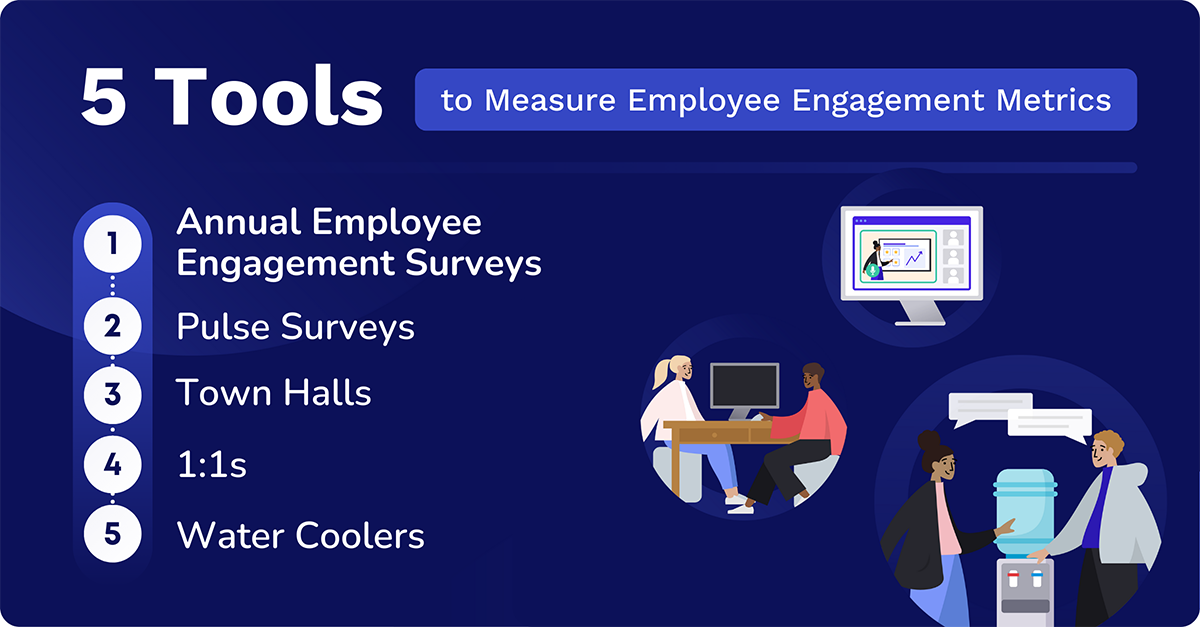
Selecting the correct metrics for employee engagement is critical to measuring and improving employee experience and engagement. Picking metrics haphazardly might not only waste valuable resources but also lead to a misguided understanding of your organization’s real state of engagement.
Making the right selection requires careful consideration of your organizational goals, a balanced approach between quantitative and qualitative data, and a consideration of industry-specific and company-size factors.
Before you dive into the ocean of potential metrics, it’s essential to align these measures with your organizational objectives. This helps ensure the data collected provides actionable insights that contribute directly to business targets. In other words, the metrics selected must reverberate the pulse of your strategic objectives.
For instance, if your organization’s primary goal is to improve retention, focusing on the voluntary employee turnover rate or the employee retention rate can be significantly valuable. These metrics provide direct insights into how well your retention strategies are working.
Similarly, if you aim to foster a team-oriented work environment, the level of employee feedback, degree feedback, or team check metric could be beneficial.
Listed below are a few recommendations for aligning your metrics to organizational objectives:

Employing a balanced approach between quantitative and qualitative metrics is crucial for a holistic understanding of your workforce’s engagement. While numerical data gives you concrete, measurable values, qualitative data adds the human touch by providing context and personalized insight.
Quantitative metrics include figures like employee performance metrics, attrition rates, HR data, and so on. These metrics offer specific numbers and percentages that can be directly mapped to organizational goals.
Qualitative metrics, on the other hand, may come from free-text feedback in employee engagement surveys or one-on-one meetings. These provide deeper insights into employee emotions, sentiments, and personal opinions regarding their work environment, professional development, and job satisfaction.
It’s crucial to strike a balance between the two. Relying heavily on either type could result in skewed insights, leading to ineffective engagement strategies.
Much like a one-size-fits-all approach doesn't work with employee engagement, applying standard metrics across different industries and companies of varying sizes could lead to misinterpretation. Different sectors have specific nuances, challenges, and expectations that should be reflected in the metrics used. Similarly, a small start-up and a large corporation have different dynamics that need a tailored approach to measuring employee engagement.
For instance, a multinational corporation might prioritize diversity and inclusion metrics because of regulatory and moral obligations. An engaged employee from this environment might manifest differently than a team member from a small business, which might be more focused on role clarity and career development metrics.
Furthermore, employee engagement metrics in an IT company might feature metrics around digital HR initiatives, whereas manufacturing firms might focus more on job safety metrics.
So, when choosing employee engagement metrics, it’s always important to consider your industry's specific needs and the complexities of your company size for a more accurate, insightful, and actionable analysis.
Quantify the financial benefits of your internal communications

Successfully deploying employee engagement metrics is not just about obtaining the datasets. The process demands meticulous planning, clear communication, employee involvement, and appropriate use of technology for data collection and analysis. This comprehensive approach leads to more precise and meaningful metrics that can improve employee engagement and organizational success.
Implementing employee engagement metrics starts with comprehensive and transparent communication. The entire workforce should clearly understand the purpose, process, and positive outcomes of this initiative. For instance, letting your workforce know that a higher employee net promoter score means their perspectives are being respected can generate a favorable response. This, in turn, will lead to more engaged employees.
Reinforcing the motive that these metrics aim to enhance the working environment and drive individual and organizational growth can also contribute to allaying any apprehensions team members may have.
Transparency about the metrics selected, data collection methodology, and how the outcomes will be leveraged should be the norm in your communication strategy. If possible, involve the HR team and staff members in crafting the communication message to ensure it speaks to everyone. This way, you foster employee buy-in, reinforcing the efficacy of implementing engagement metrics.
Involving employees in the process of implementing engagement metrics is critical for successfully capitalizing on them. It generates a sense of shared ownership, making employees feel valued and engaged. Here are some great ways to get employees involved.
Making employees a part of the solution cultivates their resilience and dedication towards the organization. As a result, you can expect enhanced engagement levels, improved productivity, and a more resilient organization.
The role of digital HR technology in implementing employee engagement metrics cannot be overstated. The right software can ensure scalable, accurate, and secure collection of large amounts of HR data. This includes but isn’t limited to employee net promoter scores and turnover rates.
For instance, an employee engagement survey platform can automate the distribution, completion, and evaluation of surveys, offering an organized way to collect and measure employee engagement. It can also provide real-time results, allowing you to track engagement trends promptly and address issues proactively.
Beyond surveys, technologies like AI and machine learning can bring more sophisticated analysis to the table. They can pinpoint patterns in vast datasets, predict future trends, and prescribe solutions. This enriches the decision-making ability of HR, streamlining efforts to improve employee engagement.
The key is to invest in a solution that aligns with your organizational scale, industry, budget, skill set, and, of course, your chosen metrics. This milestone choice can make your data collection and analysis process far more effective and efficient.
So, where to from here?
First of all, do you know that Cerkl Broadcast has a suite of internal communication software that is suitable for all organizations, regardless of structure or size? Designed for internal communicators, it serves as a centralized hub for all communication assets. This will ensure that internal communicators can easily access and manage information, making planning considerably more effective.
The platform has many superior features including content scheduling, the ability to segment audiences, and an option to create custom dashboards. But, in the context of this post, Broadcast also has great feedback and analytics tools that allow internal communicators to measure message impact.
The great news is that Cerkl Broadcast offers a free intereactive worksheet that will enable you to calculate your internal communications ROI. All you have to do is enter the data. Our ROI calculator will do the rest. What are you waiting for? Download our IC ROI Calculator right now. It's free and easy to use.
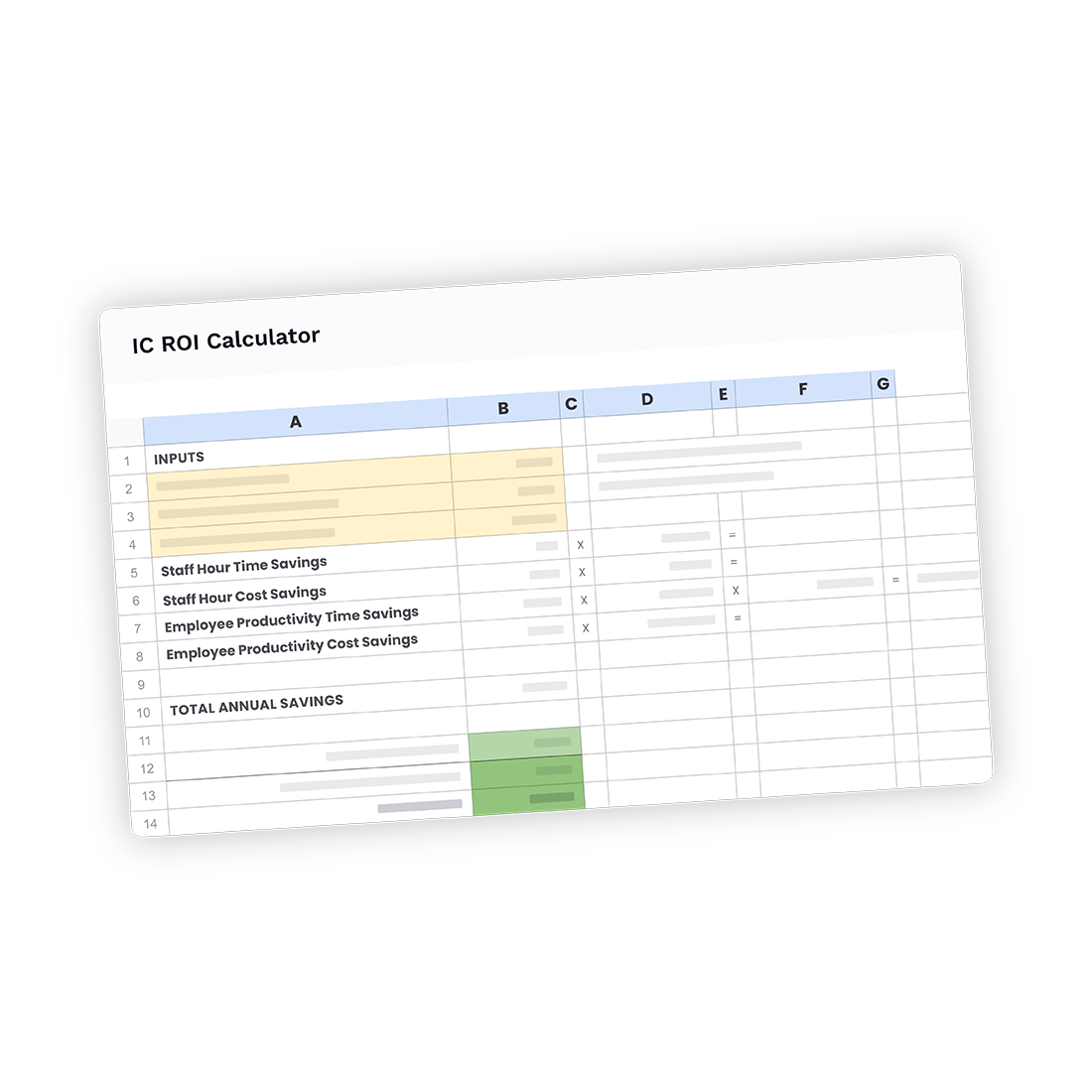
Quantify the financial benefits of your internal communications
What is the metric of employee engagement? The metric of employee engagement typically involves assessing the level of commitment, enthusiasm, and connection employees have with their work and the organization.
How do you measure employee engagement? Employee engagement is often measured through surveys, feedback mechanisms, and key performance indicators (KPIs). These all gauge factors such as job satisfaction, motivation, and overall workplace well-being and happiness.
What are the parameters to measure employee engagement? Parameters to measure employee engagement include factors like job satisfaction, communication effectiveness, recognition and rewards, career development opportunities, and the sense of belonging within the organization.
What are KPIs for people engagement? KPIs for people engagement are essentially employee engagement metrics. They may include metrics such as employee satisfaction scores, retention rates, participation in company initiatives, and productivity levels.

Quantify the financial benefits of your internal communications